
Mathematician Bernhard Riemann gave his famous lecture "On the Hypotheses Which Lie at the Foundations of Geometry" #OTD in 1854. He expanded on ideas introduced by his mentor Gauss and introducing what we now call Riemannian geometry.
Image: Familienarchiv Thomas Schilling
Image: Familienarchiv Thomas Schilling

Riemann's geometry is broader than the geometry axiomatized by Euclid. He generalizes the infinitesimal version of the Pythagorean theorem describing the distance between two nearby points, and dispenses with the infamous 5th axiom about parallel lines.
(Euclid's 5th postulate basically says that if I give you a straight line and a point not on that line, both in a plane, you can draw a second line through the point that never intersects the first line. That's not true on intrinsically curved surfaces like a globe or a saddle.)
Riemann introduced a number of now-familar concepts in his lecture: the metric tensor as the quadratic form governing infinitesimal distances, curved spaces of arbitrary dimension, geodesics and normal coordinates, the Riemann curvature tensor.
And he explicitly asks whether or not his approach to geometry, based as it was on mathematically local statements about space, could be a valid description of physical reality if matter is discrete. He then suggests that this was a question for physicists, not mathematicians.
Others would try to shape Riemann's ideas into a theory relating the motion of matter and the curvature of space. Clifford's "Space Theory of Matter" is a notable example (though he reverses the regimes where curvature is / is not important).
https://twitter.com/mcnees/status/1230907076370714625
It was Einstein, of course, who finally sorted it out. Riemann's work (following Gauss, Lobachevsky, and others) freed mathematicians from rigid notions of space and geometry, and provided Einstein with the mathematical framework needed to express the ideas of general relativity.
Anyway, the story of Riemann's lecture and the work leading up to it is a who's who of 19th century mathematics.
mathshistory.st-andrews.ac.uk/Biographies/Ri…
mathshistory.st-andrews.ac.uk/Biographies/Ri…
• • •
Missing some Tweet in this thread? You can try to
force a refresh












